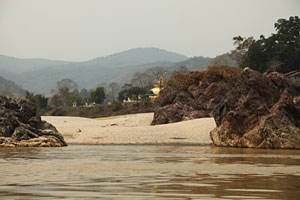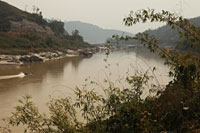from one repressive regime to another—Great Walls of concrete on the rivers of Burma
The Irrawaddy River is sourced in disputed territory on the Burma-Tibet border. It is the largest river in Burma, and is fed by a number of tributaries. It's not clear whether the source of the Irrawaddy lies in Tibet or on the Burmese side, but in any case, a major feeder called the Dulong Jiang originates to the north of Tibet near Chayu County, runs through the NW corner of Yunnan (Gongshan County) before feeding into the Irrawaddy.
In Burma, two tributaries called the N'Mai and Mali Rivers join forces to form the Irrawaddy further downstream.
The following paragraph is from burmariversnetwork.org

"Burma's military government signed an agreement with [state-owned] China Power Investment Corporation in May 2007 for the implementation of seven large dams along the Irrawaddy, Mali, and N'Mai Rivers in Kachin State. The largest of the seven, the Myitsone Dam, is located at the confluence of the Mali and N'Mai Rivers at the creation of the Irrawaddy. The dam would destroy the confluence, one of the most significant cultural heritage sites for the Kachin people and an important landmark for all of Burma."
The blueprint for Mytisone Dam is for a structure 152 metres in wall-height, with a whopping capacity of 3,200 MW. The reservoir of the dam will flood an area larger than Singapore in one of the world's 'hotspots' of biodiversity. Animals impacted include the already-endangered Irrawaddy Dolphin. An estimated 10,000 people will be displaced, losing their livelihoods and natural resource base. Construction for Myitsone Dam started in December 2009. In April 2010, the dam builders were temporarily shut down when the offices and equipment for Asia World Company and the Ministry of Electric Power were hit by a series of bomb blasts.
In September 2011, in a rare 'victory' for anti-dam campaigners, Burmese President Thein Sein announced the suspension of Myitsone Dam project. However, this is not a cancellation. What was announced was the suspension of the project for Thein Sein's term in office, which runs to 2015. Since the announcement, it would appear that Chinese workers are still at the site, possibly building an electric transformer. China has called on Burma to restart the project. Locals report that there is activity at night-time at the Mysitsone site (access to the dam location is blocked). Kachin people in five villages that were bulldozed in 2010 to make way for the project have not been allowed to go back to the area. Close to Myitsone, gold-mining and logging continue on a large scale, at breakneck pace. President Thein Sein has made no announcement about the other six Chinese-engineered mega-dams slated to be built on Irrawaddy tributaries—which will have the same impact on the Irrawaddy as Myitsone Dam. All in all, a hollow victory for Burma's anti-dam crusaders. Ethnic Kachin groups have declared that they will attack Chinese dam-building sites in the north.
There are dozens more Chinese-built and financed dam projects on-going in Burma. For locations and more data, visit: burmariversnetwork.org.
And where is this mega output of hydroelectricity going? To impoverished villages in Burma? No. It would appear that the hydroelectric output is bound for China, through some system of power transfer. And the revenues from all this are expected to line the pockets of the junta and their cronies.
Environmental organisations have raised concerns about the ecological impact of these mega-dams on the biodiverse eco-systems of Burma's rivers. China's dismal environmental practices concerning dam-building have given environmentalists every reason to be apprehensive. Speaking about foreign environment activists here. Burmese environmentalists have no way to confront Burmese military, except from bases in exile.
